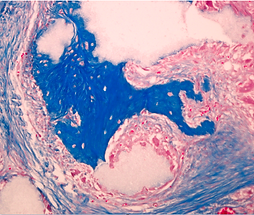THE MIRON LAB

Click to learn more!
1) Design of model systems to assess cellular interactions with bio-active materials
We are investigating the above areas through:

One of the primary focuses of our research team is to develop and investigate novel regenerative agents that facilitate tissue wound healing events. The scope of these research topics primarily involves growth factors. One of the main focuses of our laboratory is to further investigate the regenerative potential of recombinant BMP9, a growth factor that has demonstrated early promise for bone regeneration. Furthermore, the Miron lab has been one of the primary developers of Osteogain, a new carrier-system for enamel matrix derivative proteins to facilitate periodontal regeneration when combined with barrier membranes and bone grafting materials.
Areas of Research

2) Collaborate with leading industrial leaders and partners to enhance the field of osteoinductive biomaterials
Since the discovery of osteoinduction in the early 20th century, innovative biomaterials with osteoinductive potential have emerged. Over the last 50 years, however, our ability to accurately describe biological phenomena has been improved dramatically by advancements in cell and molecular biology. The aim of this research focus is to divide the osteoinduction phenomenon into 3 principles: (1) mesenchymal cell recruitment, (2) mesenchymal differentiation to bone-forming osteoblasts, and (3) ectopic bone formation in vivo. Furthermore, a recent review article published with Professor Yufeng Zhang (Wuhan University, China) in the Journal of Dental Research in 2012 formulated guidelines for in vitro and in vivo experimental testing for accurately defining new biomaterials as osteoinductive. These concepts and guidelines along with the support of leading industrial partners, aim to guide the future direction of emerging biomaterials in bone regeneration.

3) Investigate and further develop platelet formulations as an autogenous source for soft tissue regeneration
Since 2013, the Miron lab has been highly focused on conducting state of the art research on new formulations of platelet concentrates for tissue regeneration. Thanks in large part to the partnership with the founder and developer of Platelet Rich Fibrin (Dr. Joseph Choukroun, Nice, France), many advancements in surgical protocols and spin centrifugations techniques have been modified and recently investigated in the Miron laboratory. For those interested in continuing education opportunities related utilizing advanced-PRF or I-PRF, please visit one of our currently ongoing presentations sites near.
4) Study immune cell interactions with various implanted biomaterials
Osteal macrophages (OsteoMacs) are a special subtype of macrophage residing in bony tissues. Interesting findings from basic research have pointed to their vast and substantial roles in bone biology by demonstrating their key function in bone formation and remodeling. Despite these essential findings, much less information is available concerning their response to a variety of biomaterials used for bone regeneration with the majority of investigation primarily focused on their role during the foreign body reaction. In strong collaboration with Professor Dieter Bosshardt from the University of Bern in Switzerland, further study into the roles of OsteoMacs are underway to better understand their function in bone biomaterial tissue integration including dental/orthopedic implants and bone grafting materials.